General description
It is well known that it is the victors who write history. What did they write about the Phoenicians?
Historians documented that the Phoenicians were known as good "mariners and merchants". Between admiration and jealousy, praise and criticism,
the Phoenicians were recognized as pacifists.
Motivated by adventure and exploration, profit and commerce, creating new relationships and expanding their knowledge,
Phoenicians have traveled the antique world to nurture their curiosity, market and exchange their products, search for others, especially
the raw material for their handicrafts.
Archeology has shown that the Phoenicians founded trading posts on the Mediterranean, thus ensuring the supply boats. Each season, they tried to push the adventure even further up beyond the Pillars of Hercules (today's Strait of Gibraltar). Besides the city of Carthage, the other trading posts were never considered by the city mothers (Byblos, Sidon, Tyre) as colonies. These posts were simply used for resupply and trading.
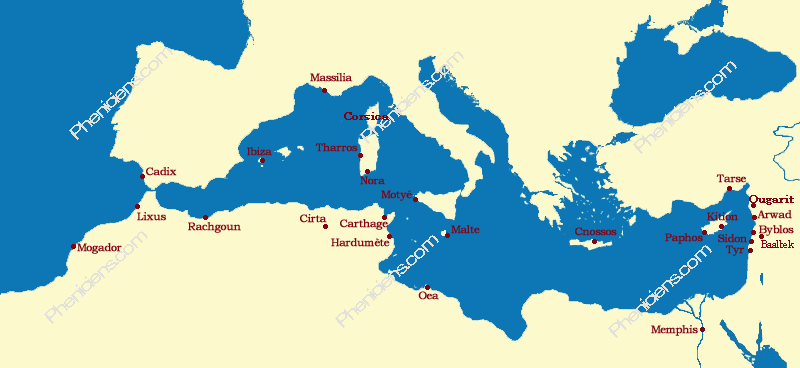
Phoenicians around the Mediterranean
Yet the history of ancient Phoenicians remains somewhat enigmatic. Up to date people are uncertain of what is a true history? And what is a myth?. A question arises: Who were the Phoenicians? Where were they? Why we named them so? Do we find Phoenicians today? What happened to this people? Lots of questions run in our heads. Within this site we try to understand the complexity of their lives, and discover a little more between their identities away from the 'clichés' since antiquity.
First we should avoid the confusion of our notion of contemporary and modern state with defined borders, and the ancient notion that is completely different. Phoenicia, the Phoenicians country, does not represent an established territory, since the boundaries followed the ebb and flow with relation to the powers of the region. Up till the early Iron Age, with the invasion of the 'Peoples of the Sea' in 1200 BC, the term 'Phoenician' did not appear.
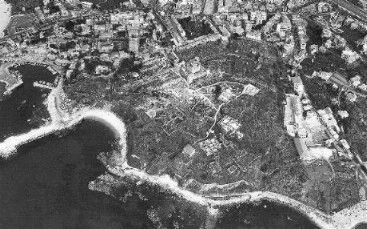
Byblos - Global view of the archaeological site
This country, which is Lebanon today with a few miles further north and south was inhabited since the Paleolithic (Old-Stone Age), and its evolution was clearly observed and recorded during the Neolithic (New-Stone Age). Around 7500 BC, the agro-pastoral economy moved on to several sites. Archaeologist Maurice Dunand found during excavations undertaken between 1924 and 1959, the remains of flint(hard grey rock) in the shape of arrows, daggers, blades denticulate to harvests, axes and scrapers, which confirmed the foundation of Byblos, about 7000 BC by Neolithic populations.
Once the IV millennium, small fishing villages grew particularly in Byblos and Dakerman near Sidon. They were formed by single-roomed houses, often grouped around a watering point and surrounded by ramparts. The men developed agriculture and fisheries, small temples were dedicated to the deities connected with the forces of nature, they began to bury their dead in large jars grain (assimilation of remains to the grain that is buried and reborn). A decisive change will soon become, bringing the village societies to evolve into more complex forms of urban organization.
At the III millennium, the model 'city-state' was stabilized and became general bringing about the development of trade. Relations were established especially between Egypt and the city of Gebal or Gubal (Byblos). Royal luxury gifts, goods, vases, boxes, flocked to the city, the oldest dating from 2700 BC. The area was then included in the Asian empire of Egypt. The cedar wood was an essential material essential to the Pharaohs to use for marine construction, and most important was the resin of the wood used for the mummification of the dead.
This situation changed at the end of the third millennium. With Egypt entering a downturn, its contacts with the Levant was interrupted. Byblos was destructed around 2200 BC but the city was quickly rebuilt around the Temple of Balaat (the Lady of Byblos) and resumed its activities. Relations with the northern coastal and inland Syria secured Byblos the supply of metal. The city became one of the most active in bronze metallurgy. The figures production started during this period, which will become the symbol of Byblos. Relations with Egypt were resumed with the 'Dynasty XII' (time of the pharaohs Amenemhet III and IV).
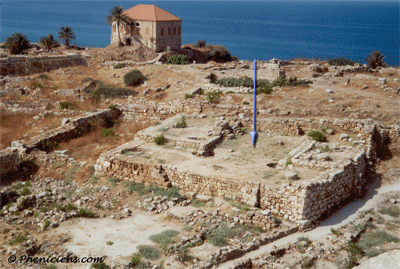
Temple of Baalat-Gebal
During the Middle Bronze Age (2000/1500 BC), the exchanges were not limited solely to the city of Byblos, several business units swarming all over: in Arqa (north), Beirut, in the Beqa 'and Kamed el-Loz. Links were particularly woven with Minoan Crete, Cyprus and other 'city-states' such Ugarit. Internationally, the political context evolved, Egypt emerged from retreat and began a new expansionist policy and several achievements were conducted. At the end of the reign of Pharaoh Tuthmosis III (c. 1440 BC), the cities of the Levant were again re-integrated into the Egyptian sphere. The government was assured by local kings who had paid tribute to the representatives of the pharaoh.
In the fourteenth century, Hittite power came in the regional arena, threatening the existing balance. Some local kings did not hesitate to establish alliances with the new conqueror. The confrontation between the Egyptian empire and the Hittite empire was realized by the famous Battle of Kadesh (1275/1274 BC) leading to a treaty between Ramses II and Hattusil III. The point of separation of territories was placed on both sides of the banks of the river Nahr el-Kabir (the current border between northern Lebanon and Syria). Levantine cities found themselves under Egyptian rule, except Ugarit who was under Hittite guardianship.
The situation of these cities was volatile and Egypt's control was insufficient. Letters addressed by local kings to the Pharaoh, testified instability and rivalry rather acute. This will later on lead to the invasion of the Peoples of the Sea (c. 1200 BC) and the destruction of major cities. Ugarit was destroyed forever. The other cities also affected by the destructive wave, managed to recover and gain some independence.
Egypt began a new downturn, the Hittite empire disappeared and the new conqueror of the East, the king of Assyria, makes only short-lived foray (Expedition Tiglath-Pileser I Arwad in 1100 BC). Until the mid-ninth century BC, Levantine cities took advantage of this freedom to expand their trade. The inhabitants defended their own entity, belonging to their own city, they declared themselves Giblites (Gebal / Byblos) Tyrians and Sidonians but never Phoenicians. This name was given by the Greeks derived from the Greek word 'Phoenix'.
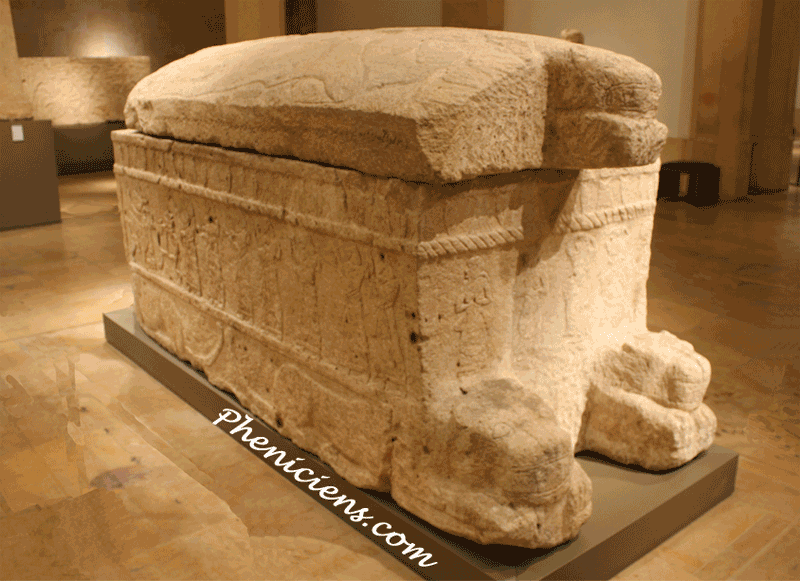
Ahiram's sarcophagus and alphabet
This period is rich in deeds, documents and relics, there are tangible traces such as the famous sarcophagus of King Ahiram Byblos bearing on its cover letters of the alphabet, the unique relationship between Hiram, king of Tyre and Solomon to build the Temple of Jerusalem, the union of Tyre and Sidon under Ittobaal royal government, bringing them up to Tartessos country (Spain) searching for silver essential material to their craft, not to forget the foundation of Carthage, first stop to Spain and Cornwall (Great Britain), who will take over later.
The Assyrian power in the East could not remain forever immune to the strategic position and therefore the wealth of commercial cities. From 880 BC, Sidon and Tyre paid a tribute to King Ashurnasirpal to protect their trading posts in northern Syria. The Assyrian threat was soon to occur, the tributes to departing Mesopotamia became increasingly heavy: cedar, precious metals, ivory, purple fabrics, etc. However, the Phoenician cities preserved their sovereignty and autonomy in managing their business. They were led by local kings while all surrounding areas were under direct control of senior government Assyrian officials. This relative independence could not mask the interference of representatives of the Assyrian king in business, which sparked several revolts in Sidon (677av. JC) and Tyre (671 & 663 BC).
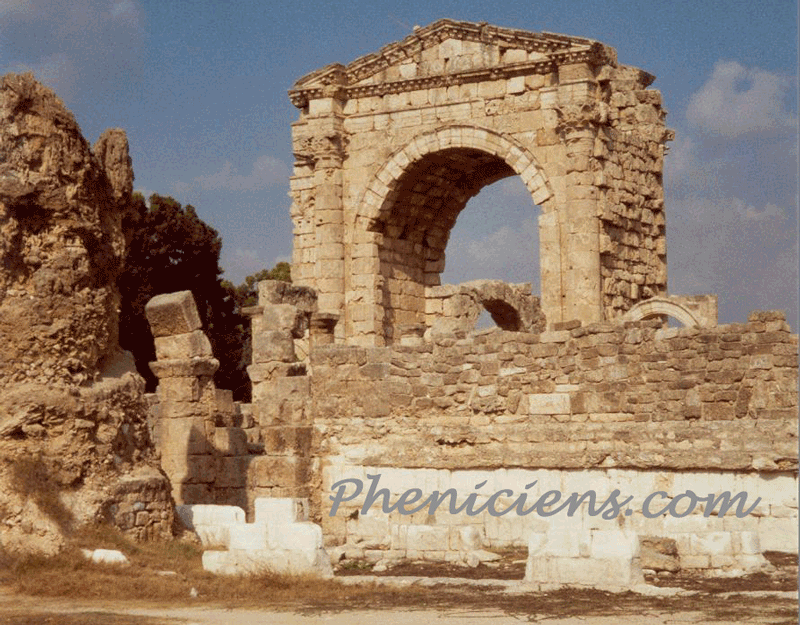
Tyre - Triumphal arch
Unlike the Assyrians, the Babylonians, new conquerors imposed full control over the Phoenician cities. From 605 BC, Nebuchadnezzar, king of Babylon, the victorious Egyptians at Carchemish, the Phoenicians deported to Babylon, ensuring total control over the wealth of the country especially the cedar forests. Only the city of Tyre resisted the siege of the invaders for 13 years.
The arrival of the Persians, after the capture of Babylon by Cyrus (539 BC), was positively felt in every city. Sailors emerged, and the Phoenicians participated, with the fleet, in the campaign against Egypt, their former ally. From an administrative standpoint, the Phoenician cities are built into the satrapy of 'Transeuphratènes' while maintaining some autonomy. From this time onward the use of Currency spread. The buildings were developed: in Sidon, the temple of Echmoun at Bostan el-Sheikh demonstrates the commitment of the royal family Sidonian the 'king of kings' (the Persian king), as mentioned in the sarcophagus of Echmounazar. In Beirut, the discovery of a neighborhood plan regular style Hippodamian evidenced by the expansion and vitality of the city at that time.
In the fourth century this cooperation was undermined. Revolts were supported by the Athenians, or even the Egyptians who tried to regain their former influence. But the Persian repression was fierce. This evolving relationship will facilitate the reception of the Macedonian, Alexander the Great, in 332 BC the cities submitted without resistance except Tyre besieged for seven months. With Alexander, the cities lost their autonomy, they will become part of a province of the Hellenistic world until the arrival of the Romans.
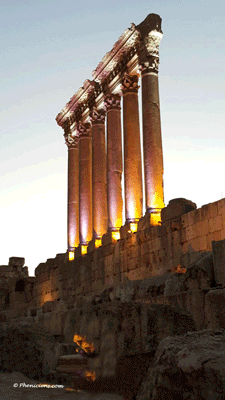
Baalbek - Temple of Jupiter, columns
The pages of this site, dedicated to Phoenicians, are multiple and diverse. You will find the history of each of the cities known as Byblos, Sidon and Tyre. Ugarit is not a Phoenician city, certainly, but through its development, richness and its trade, has been heralding the rich cities of the Levant. As for Baalbek, known more for its relics of Roman times, it was already inside the city of excellence by taking the route between the cities of the coast and the hinterland. Other pages are dedicated to specific topics as the alphabet, art, money, expansion, the personalities such Ahiram, Hannon ... or mythical heroes: Europe, Adonis ...

Preserving memory
Secure the future

With our motto, we work to preserve the memory of Phoenicians who, unfortunately, are increasingly excluded from historical books. Few people remember their contribution to create the alphabet or their maritime exploits. The most difficult thing is to define their geographical area, and their cultural involvement. It is very important to reveal how the envious have managed to 'tarnish' the name of the Phoenicians.
This site is for informational purposes about Phoenicians. It is not meant to in any way to be 'ideological'. We explicitly reject any confusion that may lead to some interpretation. Our items are annotated and referenced respecting the work of historians and archaeologists who are doing their utmost to shed light on the people long 'forgotten'. Our pages are constantly changing and the style is simple, accessible to all. A guestbook is available for any comments or suggests.






